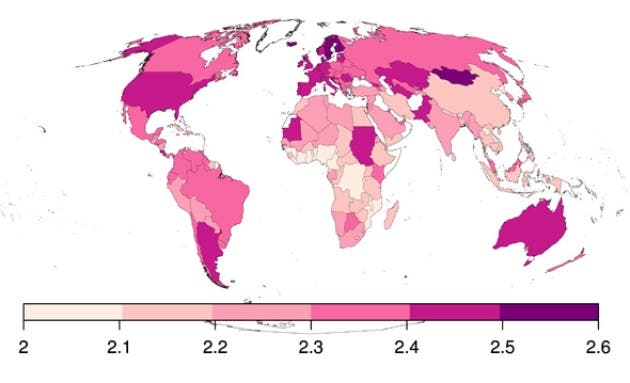Humans and the food chain

A country-by-country breakdown of the median human trophic level, which shows humans’ place in the global food chain. Explanation below. REF. 1
A country-by-country study has shown that the fast-growing economies of India and China are riving a global increase in meat consumption, cancelling out decreases elsewhere. This has serious negative environmental implications. The work analyzed both what people eat, as well as the trends of what they are eating. They also calculated an ecological metric called trophic level, something which positions the species on the food chain. The median human trophic level shows humans’ place in the global food chain on a scale that goes from 1 (organisms that get their energy from the Sun – algae and plants) to 5.5 (top predators such as polar bears, lions or sharks). Here’s how the graded scale works: – plants and algae which get their energy through photosynthesis are on level 1 – animals which eat only plants, such as rabbits for example, are level 2 – foxes, which eat herbivores (and perhaps occasionally fruits) are level 3 – Cod, a fish that eats other fish, claims level 4 – top predators, which have no natural enemies (humans aside) and can eat pretty much anyone take levels up to 5.5. Humans, as it turns out, are somewhere at approximately 2.2 – but that’s nowhere near the most relevant thing they found out.
Moving up

Globally, the human trophic level increased by 3% from 1961 to 2009, driven largely by more meat consumption in India and China. REF 1
The study, conducted by Sylvain Bonhommeau, a fisheries scientist at the French Research Institute for Exploitation of the Sea in Sète, estimates that humanity’s global median trophic level was 2.21 in 2009 – an expected value which puts us on par with other omnivores, such as pigs or anchovies.
“We are closer to herbivore than carnivore,” says Bonhommeau. “It changes the preconception of being top predator.”
However, the study also showed that the average value for all humanity has been going up. Over 50 years, an increase in fat and meat consumption has increased the human trophic levels by 3% (or a value of 0.06) in the past 50 years. The researchers calculated the human trophic level for 176 countries for each year from 1961 to 2009 using a data on 102 types of food, compiled by the Food and Agriculture Organization (FAO) of the United Nations.
“It seems like a small difference, but when you think about how it’s calculated, it’s big,” says Thomas Kastner, an environmental scientist at Alpen-Adria University in Vienna, who was not involved in the study. An organism’s trophic level is calculated by summing the trophic levels of the foods in its diet and the proportion in which they are consumed. “A change by 0.1 means you are eating considerably more meat or animal-based foods,” says Kastner.
However, changes are not uniform on the globe; the main increase at the global level is driven by China and India. Basically, in these countries, hundreds of millions of people have risen from poverty and moved on from meals which revolved mostly around rice (or other similar basic carbohydrate-centered meals) to more diverse, meat-rich meals. Still, on the other side of the spectrum, traditionally meat-eating countries such as Mongolia, Norway or Iceland have seen their trophic levels decline as they diversify their meals. Basically, most of the world is diversifying its meals (upward or downward on the trophic level), but because the huge populations in China and India, their impact greatly outweighs all others. The impact of switching to a more meat-based diet can be devastating to the environment. Calorie for calorie, meat is several times more environmentally expensive (in terms of water and energy) than other, vegetable foods. Furthermore, a 2006 FAO study found that livestock industry is directly or indirectly responsible for 18% of global greenhouse-gas emissions — a larger share than all modes of transport combined.
“If we all increase our trophic level, we’ll start to have a bigger impact on ecosystems,” says Bonhommeau.
Journal Reference:
- Sylvain Bonhommeau et al. Eating up the world’s food web and the human trophic level. http://www.pnas.org/cgi/doi/10.1073/pnas.1305827110 (2013).









